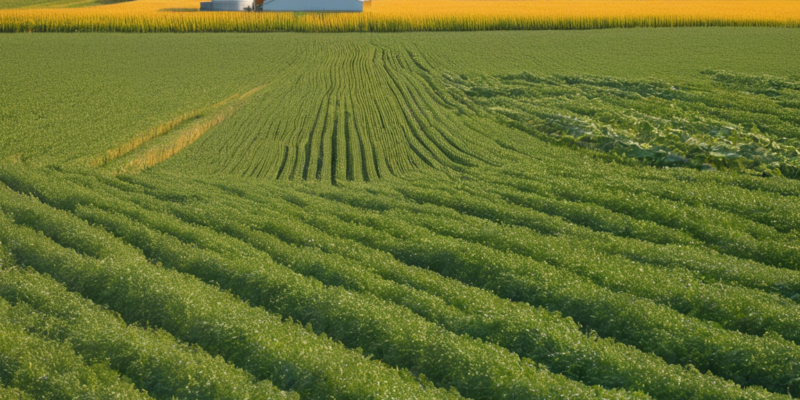Agriculture plays a vital role in the economy of Ontario, Canada, with the province being a major producer of a wide variety of crops. Each year, new trends emerge in the agricultural sector, driven by advancements in technology, changing consumer preferences, climate change, and evolving market demands. In this article, we will delve into the top crop trends that are shaping Ontario’s agricultural landscape.
Embracing AgTech Solutions
Precision agriculture techniques are gaining popularity among Ontario farmers as they seek to optimize crop yields, reduce input costs, and make more sustainable farming decisions. Technologies such as GPS mapping, drones, sensors, and data analytics are being utilized to monitor crop health, soil conditions, and weather patterns. By adopting these AgTech solutions, farmers can make informed decisions that lead to increased efficiency and productivity.
Focus on Sustainable Practices
Sustainability is a key focus in modern agriculture, with consumers increasingly demanding environmentally friendly and ethically produced food products. In Ontario, farmers are incorporating practices such as crop rotation, cover cropping, reduced tillage, and integrated pest management to enhance soil health, protect water quality, and reduce greenhouse gas emissions. Implementing sustainable practices not only benefits the environment but also ensures the long-term viability of the farming operation.
Climate Change Resilience
Ontario farmers are facing the challenges posed by climate change, including more frequent extreme weather events, shifting growing seasons, and unpredictable rainfall patterns. To adapt to these changes, farmers are exploring resilient crop varieties, irrigation systems, and crop diversification strategies. By selecting crops that are more tolerant to heat, drought, or flooding, farmers can mitigate the impact of climate variability on their yields.
Demand for Specialty Crops
Consumer preferences are evolving, with an increasing demand for locally grown, organic, and non-GMO crops. Ontario farmers are diversifying their crop portfolios to include a variety of specialty crops such as quinoa, hemp, edamame, and Korean ginseng. These crops not only cater to niche markets but also fetch premium prices, providing an additional revenue stream for farmers.
Expansion of Horticulture Production
The horticulture sector in Ontario is experiencing growth, driven by a rising demand for fruits, vegetables, herbs, and flowers. Urbanization, changing dietary habits, and a focus on health and wellness are contributing to the increased consumption of horticultural products. Farmers are investing in high tunnels, greenhouses, and hydroponic systems to extend the growing season, increase yields, and ensure consistent crop quality.
Collaboration in the Supply Chain
Collaboration across the agricultural supply chain is becoming more prevalent in Ontario, with farmers, processors, retailers, and consumers working together to ensure food safety, traceability, and sustainability. Initiatives such as direct-to-consumer sales, community-supported agriculture (CSA) programs, and farmers’ markets are fostering greater connections between producers and consumers, promoting transparency and trust in the food system.
In conclusion, Ontario’s agricultural sector is witnessing a transformation driven by technological innovation, sustainability initiatives, changing consumer preferences, climate change resilience, crop diversification, and supply chain collaboration. By staying abreast of these top crop trends, farmers can adapt to the evolving landscape, seize new opportunities, and contribute to a more resilient and sustainable agricultural future.
Frequently Asked Questions (FAQs) about Crop Trends in Ontario Agriculture
-
What are some of the most commonly grown crops in Ontario?
Answer: Ontario is known for producing a variety of crops, including corn, soybeans, wheat, barley, fruits, vegetables, and dairy products. -
How are Ontario farmers adapting to climate change?
Answer: Ontario farmers are adopting climate-resilient crop varieties, implementing irrigation systems, and diversifying their crops to mitigate the impact of climate change. -
What role does technology play in modern agriculture in Ontario?
Answer: Technology, such as precision agriculture tools, drones, and data analytics, is helping Ontario farmers optimize crop yields, reduce costs, and make more informed decisions. -
Why is there a growing demand for specialty crops in Ontario?
Answer: Consumers are showing increasing interest in locally grown, organic, and unique crops, leading Ontario farmers to diversify and grow specialty crops to meet market demands. -
How can farmers in Ontario enhance sustainability in their practices?
Answer: By adopting practices such as crop rotation, cover cropping, reduced tillage, and integrated pest management, Ontario farmers can improve soil health, water quality, and reduce environmental impact. -
What are some examples of specialty crops grown in Ontario?
Answer: Specialty crops grown in Ontario include quinoa, hemp, edamame, Korean ginseng, and various herbs and spices catering to niche markets. -
How can farmers in Ontario benefit from collaboration in the supply chain?
Answer: Collaboration in the agricultural supply chain can enhance food safety, traceability, sustainability, and promote direct connections between producers and consumers. -
What are some of the challenges faced by Ontario farmers in the horticulture sector?
Answer: Challenges in the horticulture sector include competition from imports, labor shortages, changing weather patterns, and fluctuating market demand. -
How can technology help Ontario farmers improve their horticultural production?
Answer: Technologies such as high tunnels, greenhouses, hydroponic systems, and automated irrigation systems can help Ontario farmers extend the growing season, increase yields, and improve crop quality. -
What initiatives are promoting sustainability and environmental stewardship in Ontario agriculture?
Answer: Initiatives such as the Environmental Farm Plan (EFP), Conservation Authorities, and research partnerships with universities are promoting sustainability and environmental stewardship in Ontario agriculture.
These FAQs aim to address common queries about the crop trends in Ontario agriculture, providing insights into key practices, challenges, and opportunities in the sector.

